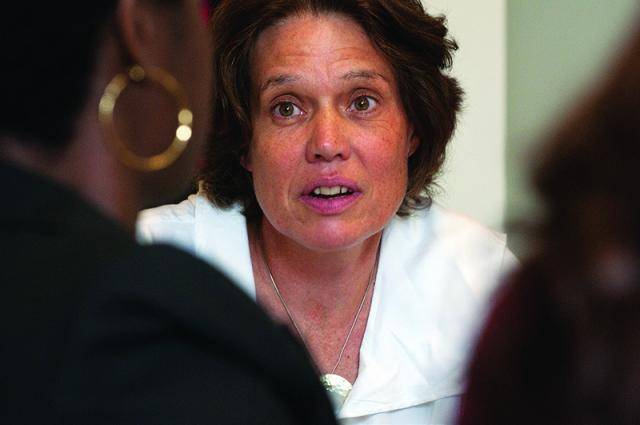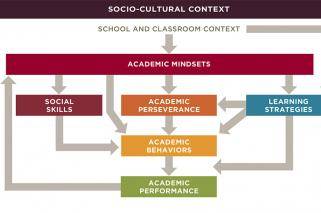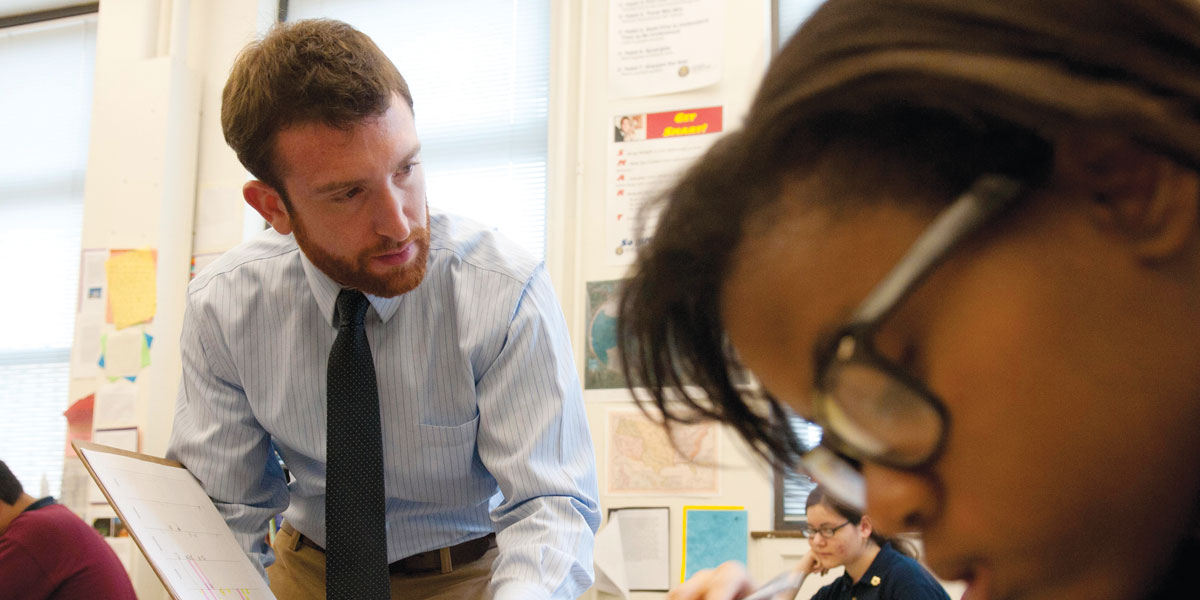Getting Their Minds Ready
A report on how “noncognitive factors” impact adolescents’ success in school fuels the movement to prepare students to learn
Standardized test scores have come to define success or failure in American education. Based on students’ scores, principals and teachers are fired, schools close, political careers rise and fall. But researchers have found that students’ standardized tests scores do not in fact predict the students’ academic success.
Abstract
More and more educational experts are paying attention to noncognitive factors in students’ capacity to learn, such as their mindset about school, their perseverance in the face of difficult tasks and the strategies they utilize in approaching coursework. SSA’s Melissa Roderick and Camille Farrington led a research team that recently released “Teaching Adolescents to Become Learners,” which gathers and organizes more than three decades of research across a number of disciplines on noncognitive factors in teen academic success. The groundbreaking report has been used by the Chicago Public Schools and others across the country as a guide to fostering these factors in high school students, and Roderick and Farrington are now studying the best ways for schools to provide those noncognitive supports.
Melissa Roderick, SSA’s Hermon Dunlap Smith Professor, has found that there is a much better predictor at hand for a student’s success—his or her GPA. “Kids need to be taught how to be good at learning, but instead we’re teaching them to take standardized tests,” she says. “We need to help students to be asking questions in class, stick with a tough assignment, feel confident in their abilities, work with their peers. That’s a big part of what it takes to do well in high school, and then go on to succeed in college and in a career.”
The bundle of skills Roderick cites are examples of what are often called noncognitive factors in a student’s capacity to learn—as compared to traditional academic abilities such as memory or content knowledge—and more and more educational experts are starting to pay attention to their importance. Traits that help kids overcome difficult backgrounds have been a hot topic in the media lately, especially with the release of New York Times writer Paul Tough’s book, How Children Succeed: Grit, Curiosity and the Hidden Power of Character.
Last year, Roderick co-authored a study on noncognitive skills, “Teaching Adolescents to Become Learners,” which synthesizes 30 years’ worth of research covering a range of disciplines, including psychology, cognitive learning sciences and economics. More than a traditional literature review, the report examines, compares and organizes a vast body of research that had previously been too broad and esoteric for educators and policymakers to get a handle on.
The report, published by the University of Chicago’s Consortium on Chicago School Research, is attracting considerable attention. Since its publication last June, it has been the most viewed page on the CCSR website, downloaded more than 5,000 times. Its authors have flown coast to coast to present their findings to foundations, educators and policy makers, including officials at the U.S. Department of Education. A network of afterschool providers in Silicon Valley began a study group to examine their practices more closely in light of the research.
“Seeing how important noncognitive factors are, educational experts are wondering how teachers can change their practice to support these behaviors,” says Camille Farrington, the lead author of the report and a research associate (assistant professor) at SSA. “It’s been gratifying to see the response, and we’re pretty excited to be going deeper into studying the implications for practice.”
One big reason “Teaching Adolescents to Become Learners” has had such an impact is its framework of five broad categories of noncognitive factors related to academic performance and their interrelated impact. Academic behaviors—attending class, participating, doing homework—underlie academic success in adolescence and beyond. Academic perseverance, often called grit, influences how consistently students choose good academic behaviors despite a difficult assignment or outside temptation.
Academic mindsets are the beliefs a student has about his or her relationship with academic work. Research finds that certain attitudes about learning can also boost GPA. They include beliefs such as “I belong in this academic community,” and “This work has value for me.”
Learning strategies include ways for students to monitor their own comprehension, develop mnemonic devices to help them recall facts, and use techniques to manage study time. Such strategies make learning easier and more effective. Finally, Roderick’s team found most research on social skills, from cooperation to empathy, is focused on early childhood and elementary education, where they were associated with academic success.
The report took a year and a half to pull together by a team of seven: Roderick, Farrington, CCSR Interim Executive Director Elaine Allensworth, Deputy Director Jenny Nagaoka and SSA doctoral students Tasha Seneca Keyes, Nicole Williams Beechum and David W. Johnson, who is CCSR’s associate director for postsecondary studies. They reviewed hundreds of academic papers, comparing evidence and shaping the framing. “It was like a weekly seminar,” Roderick says. “As a student I have learned more from working on this project about what it means to be a scholar than I have elsewhere,” Seneca Keyes says.
When it was done, the team found a clear case for schools to explicitly teach kids how to learn and for building their confidence as learners. For example, says Roderick, if a student thinks the way to study is to simply read over notes, the task will be done quickly with little information retained. A strategy of searching the notes for main ideas, putting them on index cards and thinking about how they relate to each other will make their studying more effective.
Such learning strategies have been found to help close achievement gaps for educationally underserved students. Research shows that African-American and white students spend about the same amount of time on homework, yet “African-American students are less likely to report that they finished it, understood it and that it helped them learn,” Roderick notes.
“I think [the report] highlights an important gap in urban education—probably all education,” says Jennifer Loudon, A.M. ’98, the director of youth development and positive behavior support for the Chicago Public Schools. Good teachers are aware of the need for kids to learn better academic habits and attitudes but aren’t necessarily equipped to teach those skills, Loudon explains. Now her team is working with the district’s academic specialists on integrating skills that are highlighted in the report into the district’s curriculum.
“The report went even further than we hoped,” says Erin Kahn, director of the Raikes Foundation in Seattle, which, along with the Lumina Foundation, commissioned the paper. “The framework for how they organized this information was really groundbreaking.”
The Raikes Foundation is planning to invest $4 million this year in research to identify specific teaching strategies related to the findings. “We’re using this report as our intellectual launch pad: Here’s what needs to be done to fill research holes,” Kahn says.
In Chicago, Lila Leff, founder of Umoja Student Development Corporation, says she’s using the report to inform teacher professional development at 12 partner high schools. “I think there’s an ongoing frustration among teachers, a feeling that there’s been an emphasis for a long time on preparing kids for [standardized] tests,” says Leff, whose nonprofit designed a high school curriculum covering skills for academic success that run from backpack organization to college application. “People realize there’s another whole part to the story.”

“We need to help students to be asking questions in class, stick with a tough assignment, feel confident in their abilities, work with their peers."
Fenger High School on Chicago’s far South Side attracted national media attention in September 2009 after a video of one of their students being beaten to death walking home from school went viral. That school year, Principal Elizabeth Dozier’s first, “we had close to 300 arrests inside the building and only 170 days of school,” she recalls. “A lot of it had to do with kids not knowing how to function in a very basic way. Someone stepped on someone’s shoe, and there was a huge fight.”
Roderick says that Dozier has done “a remarkable job” in providing supports to kids that build good academic behaviors and mindsets. “Especially in a school community like Fenger, they need to wrap their arms around kids in all sorts of ways and then start pushing them to learn,” she explains. “That’s the way to engage these kids—we can’t just ask them to automatically manage it on their own.”
Among other strategies, Fenger adopted the Boys Town system for teaching 16 specific social skills for classroom behavior and peer interactions, including how to disagree appropriately with someone, stay on task and get the teacher’s attention. Each goal is taught in simple, step-by-step instructions and posted on walls throughout the school for reference.
“It’s very easy for us to assume that students know this stuff,” says English teacher Thomas Goodwin. “But as freshmen, they have so many things going on that it’s important to reinforce these procedures and routines.”
To make sure kids are at school, Dozier has recruited students as attendance coaches, who text or phone late sleepers to make sure they get to school on time. For better compliance on homework, teachers set the same rules in every classroom. “Now it’s a school-wide expectation,” freshman writing teacher Sarah Brown says. “And since all of the teachers require it, that behavior is engrained in their heads, ‘We do homework.’”
At Fenger, students who fall behind aren’t left to struggle. Freshmen with a “D” or “F” average in a course spend a lunch period each week in a small group with their teacher. Those who miss a class are required to make up time after school. Senior Christina Williams, an attendance monitor, says she even walks her charges to the afterschool “personal development” room to make sure they get there on time. “I want them to know that there’s somebody who cares,” she explains.
Quick interventions like these help prevent a downward spiral, says Roderick. She points out that studies have shown that poor academic performance can lead to negative attitudes about school and one’s ability, which further dampen motivation and damage performance. Minority students are especially vulnerable to mindsets that can undermine learning because of negative stereotypes about their alleged intellectual inferiority, research has found.
The report also notes, though, that interventions that change mindsets can narrow racial and ethnic learning gaps. In one experiment, college freshmen watched videos that helped them see the challenges in transitioning to college as normal and not the result of their racial identity. Compared to a control group, those college students posted higher grade point averages and cut the racial performance gap in half.
During his first semester at Fenger High School, Freshman Miquario Sanders almost fell into a negative spiral himself. “My first mindset was this is going to be harder than anything, and I’m pretty sure I’m not going to know the stuff they’re going to try to teach me,” he recalls. “I really didn’t want to come.”
But his teachers didn’t give up on him, he says, even after a poor report card first semester. He got sent to extra help on his lunch period and made up some missed class work after school. In class, teachers monitored his behavior. “My math teacher, if I start to slack off, he’ll come nudge me, ‘Do your work.’ I feel like all the teachers here care about me,” he adds. “Now that I pay attention, I honestly think I can be successful.”

"Teaching Adolescents to Become Learners" includes hypotheses about the complex interaction between the five noncognitive and other factors on academic performance.
High schools like Fenger already have tactics to help their students learn effective noncognitive skills, and thanks in part to the report’s findings, programs such as the CPS initiative are beginning to spread these practices even further. But while Farrington, Roderick and their co-authors found that educators can make an enormous difference in students’ academic behaviors, they also found that schools and teachers who do intervene are largely relying on their own “home grown” strategies there’s little empirical research on what specific interventions work.
“Most evidence of noncognitive impact has been in lab settings and intervention studies, not natural classrooms,” Farrington says. “There’s not a lot of research on how class structure and the institutional environment affect noncognitive learning. There’s been little study of what teachers do to support these noncognitive factors and almost none on how to teach educators to effectively teach these behaviors to their students.”
Roderick and Farrington have recently begun two new research programs to fill in some of this gap. Their research team developed a survey about becoming an effective learner that was given to more than 9,000 students this winter in grades 6-12 across the country. The results of this pilot are currently being analyzed, with the results informing a broader survey next fall.
And in April, Farrington and Roderick launched a new teacher net- work at three CPS high schools and five elementary schools, the beginning of a three-year study to measure how teachers can improve noncognitive factors for the students in their classrooms and how a professional network, modeled on the work of SSA’s Network for College Success, can help. The project, housed at SSA and being run in conjunction with the Consortium on Chicago School Research, will “see how teachers can change their practice,” Farrington says, “and does that affect how students experience school.”
“With all the talk about noncognitive skills, there’s a lot we just don’t really know yet,” Roderick says. “People are talking about a 45-minute course for students to learn these things, and it’s supposed to change their lives. That’s unlikely. We do know noncognitive factors are really important. Now we’re starting to find the evidence of what works to help students build these factors.”



